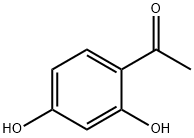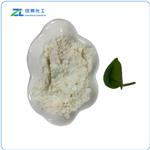Chemical Properties
2,4-Dihydroxyacetophenone appears as a yellow-brown to reddish-brown fine crystalline powder. It slowly decomposes in water and can dissolve in hot alcohol, pyridine, and glacial acetic acid. In contrast, it is nearly insoluble in ether, benzene, and chloroform. A reaction with iron chloride causes it to adopt a red hue.
Uses
2,4-Dihydroxyacetophenone (cas# 89-84-9) is a compound useful in organic synthesis. It is also used as intermediate for pharmaceuticals. Reagent for iron as a 10% alcoholic solution. A red color is obtained with ferric ions in slightly acid solution: Cooper, Ind. Eng. Chem. Anal. Ed. 9, 334 (1937).
Preparation
Preparation by reaction of acetic acid on resorcinol,
with zinc chloride (Nencki reaction) (94%)
with boron trifluoride
with Amberlite IR-120 (a cation exchange resin, sulfonic acid type) (87%)
with polyphosphoric acid (63%)
with 70% perchloric acid (33%).
Definition
ChEBI: 2',4'-dihydroxyacetophenone is a dihydroxyacetophenone that is acetophenone carrying hydroxy substituents at positions 2' and 4'. It has a role as a plant metabolite. It is a member of resorcinols and a dihydroxyacetophenone.
Synthesis Reference(s)
Journal of the American Chemical Society, 70, p. 428, 1948
DOI: 10.1021/ja01181a521
Safety Profile
Moderately toxic by
ingestion. Experimental reproductive
effects. A severe eye irritant. When heated
to decomposition it emits acrid smoke and
irritating fumes.
Synthesis
2,4-Dihydroxyacetophenone is obtained by the acetylation of resorcinol and acetic acid. In addition, it can also be obtained by reacting resorcinol with chloroacetyl or acetic anhydride in the presence of zinc chloride.
target
Phospholipase (e.g. PLA)




